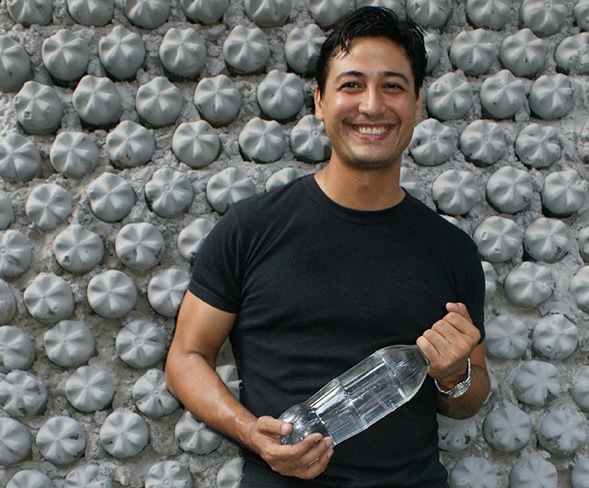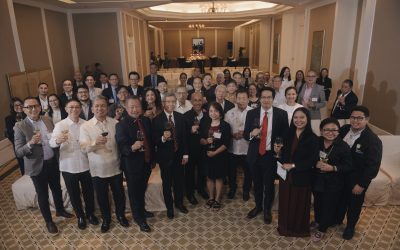Illac Diaz is a social entrepreneur working to empower communities in the Philippines and around the world through several pioneering programs in rammed earth, bamboo, and PET plastic bottle construction. He founded the MyShelter Foundation in 2006 to promote grassroots sustainable development through capacity-building and employment-generating projects.
Illac’s vision is to improve one million lives a year and to reframe the way people think about solutions to climate change – not as a product of industrialised nations, but as a gift that developing countries can share with the rest of the world.
The Columnist interviewed him on his inspiration and thoughts behind the projects.
The Columnist (TC): You were able to apply and scale the potential of a simple but ingenious concept. How did you end up choosing this object to be the focus of your cause?
Illac Diaz (ID): We began really with trying to look at how small NGOs could cross into the next NGO 2.0, imitating how social networks engage people virally. We’re always joking about how pressing “like” would never feed anyone or change the life of anyone. We wanted to apply the technologies behind social networks, to solve large scale problems virally. Through the viral videos, we were interested to see if we could come up with a very simple viral technology that was applicable anywhere in the country.
The design followed 3 fundamental rules:
- If it was to be viral in application, the people should be able to gather the materials in their immediate environment. Nothing should come from mother foundation. Once they see the viral solution or viral app, it has an appropriate technology that can function from the ground.
- It should take simple skills. If we send it over the internet, you cannot make it too specific to one source that might not be common. Right away, people will not use it.
- It should have an immediate impact that it would turn into something that everyone wants. And the ideal is it would be something that would create a business.
That way, 1) From the geometric spread by the online social network, the more people know about it, the more chances people will apply for it. 2) It should not be too difficult so people will be willing to try it out. 3) After the person tries it out, it could become a local livelihood program. These were the themes we had by wanting to come up with a dream – how do we help a million people a year? Is that at all possible with social networks, with the Internet and all that it’s capable of doing, rather than just a process of sending and receiving information? Simple in design and supply, simple in build. It’s so simple, we are looking for grassroots kind of entrepreneurs to continue the movement into a business proposition.
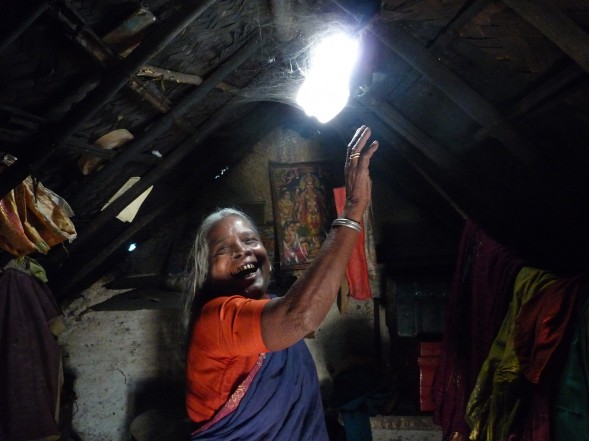
MyShelter’s latest venture, 1 Liter of Light, is the world’s first grassroots green lighting program bringing low-cost, zero-carbon solar bottle bulbs to underprivileged communities worldwide. By empowering local entrepreneurs and marginalised groups like prison detainees and trash pickers, this initiative shows how simple solutions powered by human hands bring the green revolution to the bottom 99%. Since its launch in April 2011, 1 Liter of Light has lit up over 200,000 households in the Philippines and around the world. PHOTO: ALITEROFLIGHT.ORG
TC: Aside from helping the underprivileged and mobilising local governments into action, in what other ways did the movement make positive change? What do you feel when you see the project succeed?
ID: MyShelter foundation, if put in its “easiest-to-comprehend” terms, is looking at society’s greatest problem, which is waste streams, and the need to convert it into a sustainable, practical and recognised social-building mechanism. Hopefully, from trash we can start building houses. You fill up a bottle with mud, it becomes a brick. You fill it with water, it becomes a light. You put it on top of each other with plants in it and it becomes a hydrophonic garden. And this is just our plastics division.
We believe instead of burying it, each town produces enough waste if upcycled and treated properly, we can reduce the landfill by half and take that half and make it into housing for the poor and all new kinds of technologies that would improve people’s lives. It really started with a crazy idea, but over the years people have seen what’s possible.
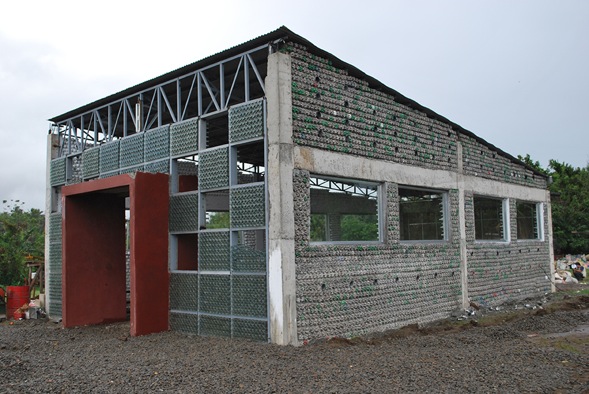
The school is made from 1.5 and two-litre soda and water bottles filled with adobe, a combo that is relatively cheaper than concrete and also about three times stronger. PHOTO: KRISTEL MARIE FUENTES GONZALES
TC: Now that the grassroots have been planted and your cause is being recognized worldwide, will there be other objects in mind that will be offshoots of the “A Liter of Light” project down the line?
ID: Absolutely. Liter of Light is a template more than anything. Our desire, beyond just impact, is the story that not all green technologies come from the first world – manufactured in expensive factories, patented and unaffordable to the grassroots. But there’s a secondary which is not top-down but bottom-up, starting from the grassroots of developing nations. It may not be initially appreciated because it is not a huge dam, a huge windmill or an expensive solar array but it is little improvements on millions of households put together that makes its impact substantial.
Liter of Light is just a template. We really hope that this will expand, with other young people coming up with the next viral application. Showing people virally how to use scrapped solar calculators to build lighting attachments to Liter of Light, that way there will be the night function of it, which will function for another 5 hours in the evening, that way it will be a complete solar set. We’re doing other innovations. Before Liter of Light, the first viral video that we hoped that would be replicated was how plastic bottles filled with soil or mud could be a substitute for bricks. We were hoping the first one will be viral but it didn’t spread that much. We’re coming out with house made out of paper. Hopefully that would catch up.
We’re still very much a research foundation. What we’re tinkering with: Can we come up with the next social-shifting technology that can be dispersed via the internet? Hopefully one day we’ll come up with mobilising technologies – which happened with Liter of Light. It was zero barely a year ago, now affecting about 300,000 houses around the world in 10 countries. It’s definitely something fruitful and we’re still beginning to understand how it works in the NGO sector. The technology is brand new so we’re still trying to discover what it can do. Liter of Light is one of our first grand successes.
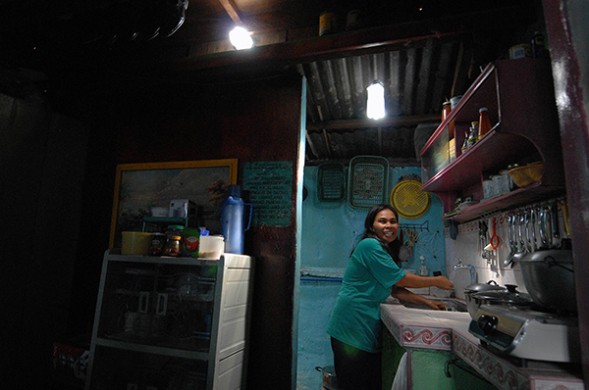
Just as bright as an electric bulb, the solar bottle bulb does not heat up, cuts down their electric bills and reduces other problems such as fires caused by faulty connections. PHOTO: ALITEROFLIGHT.ORG
TC: Is there any object in the Philippines that you feel is meaningful to you?
ID: We’re beginning to use rubber from discarded tires for housing construction and also for furniture. We will be using recycled paper for infrastructure and housing. The plastic bottles – people have seen how it can be used as brick or lighting.
Whatever is in the waste stream [is meaningful], as long as we can develop it as a tool to alleviate poverty. Our next love will be thrown away paper – how we can use that as a great solution to poverty.
TC: In today’s age of consumerism, rubbish – things we don’t really need – are peddled like they’re gold. A stark contrast to how MyShelter is turning rubbish into gold. What are your thoughts on this?
ID: With consumerism, what’s forgotten is that there’s a certain responsibility which must be fulfilled. As you consume, will there be a backlash? Is it toxic to the environment? In the end, are we creating a more livable society? Unfortunately, consumerism will be the pattern until there is scarcity – the point where we’re consuming more than what the earth can accommodate and replenish. MyShelter sees it as a trend and we’re a small foundation taming the beast – we take what we can and use it to improve human (living) condition – certain necessities like a roof over their heads, food for nutrition. And to solve these problems, we have to look at the abundant resources in the things we throw away before they’re buried forever, and upcycle them, giving them purpose.
TC: Can we still change consumerism into a more practical socio-economic culture? What do you think are the requisites to make this ideal change happen? If it does eventually happen, what products/innovations do you suppose will emerge from it?
ID: Let’s look at the trend on how it is: Those who have the purchasing power to live a certain lifestyle, unfortunately, have not realised what is excess. Just realise that our resources are finite, so by taking more than we need for ourselves, the less there are for the rest of us. There are nations that consume about 25% of the world’s resources and they’re just a small portion of the world’s population. You really see how it works and you can’t stop it. Although you cannot stop the consumers from wasting more and more of our resources, it should not impede us from our goal. The resources they throw away are very rich in potential and are gold to us. That’s what we’re investing in – to acquire machines that convert these discarded resources.
We want to create systems where people can donate these to us before throwing them in the trash bag. We hope that they will see the value of their trash. To think, “Why am I throwing away certain objects that are valuable and can still be useful?” We want to be one of the world’s biggest upcyclers of trash (into products that has social impact). We’re just still at that point where we say, “Sayang, makakatulong pa yan.” (What a waste, that could still help). This is one of the things I’ve learnt from my grandfather who came from the “we-can-fix-it” generation. So if something is “puwede pa,” (can still be used), we’d look for spare parts and repair it. Now, it’s sort of a “throw away” generation and as I mentioned, we’re consuming more than what the world can replenish, and we’re going to pay heavily for it.
MyShelter’s role, as an NGO, is to alleviate poverty so “kung pwede pa yan, bakit hindi, diba?” (if it can still be used, why not, right?) In its simplest form, that’s it. But we’re not talking about just old clothes or worn out pair of shoes, we’re talking about tons and tons of garbage that can be converted into human shelter.
TC: The worldwide movement for change has been growing strong for the past decade, and plenty of these advocacies have become communities where people can share the hope and the enterprise of having a better future. Please share your encounters with these like-minded people, and how they have affected you – your viewpoints and your mission.
ID: Movements put a lot of effort on awareness. Advertising for awareness. A cause for awareness. A run for a cause. You go to a rock concert and it’s about the environment but when you ask “Okay, what do we do now?” you’ll never know what it is. So, we have very very strong awareness but you really never know what the impact is.
I’m really more for those causes that are solutions-based and has actual impact and results. That’s where I believe more effort should be put into, because awareness, over time, has been done and we already know what it is. To spend so many millions of pesos in having awareness without solutions is, “Sayang, puwede pa ito sa iba.” (What a waste, it could have been used for something else.)
I have met some very like-minded people in the world of appropriate technologies – technologies that can be built, replicated and diffused at the bottom of the pyramid. One example is my very good friend, Jen, who’s been doing very well with a wax product that you can heat up and its warmth remains for quite a while. For those who can’t afford to use infant incubators, it can be used to wrap newborns to save them from hypothermia. Very simple technologies that make a world of difference.
The input in our technology is waste, and the output is inventions that have an effect on shelter. That’s why it’s called MyShelter – so anything about shelter and anything about life in that shelter.
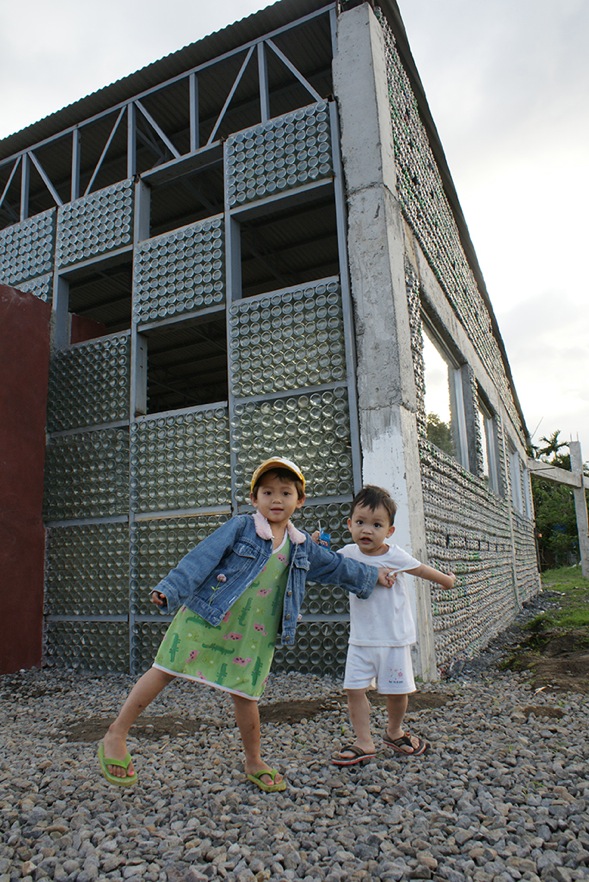
The innovative bottle building was conceived as a way of turning a negative – an abundance of discarded plastic bottles – into a positive – a brand new school for children. PHOTO: KRISTEL MARIE FUENTES GONZALES
This interview was conducted for The Columnist, a newsletter by Consulus that offers ideas on business, design and world affairs. The views expressed in this article are those of the interviewee and do not necessarily reflect the views of Consulus.

